But do providers know the digital healthcare landscape well enough, and are healthcare organizations open to embracing trends in health technology? Join Dropstat as we examine the increasingly important function that digital transformation serves in healthcare.
What is digital transformation in healthcare?
The definition of digital transformation in healthcare is changes in healthcare related to
- use of the internet
- digital technologies
- information management technologies
- healthcare management
- and business as it relates to healthcare.
Some transformations in healthcare arise due to the growth of AI solutions. Examples of how AI supports healthcare practice include:
- medical image analysis
- pathology and telemedicine
- remote patient monitoring
The future of AI in healthcare indicates many more developments and applied inventions.
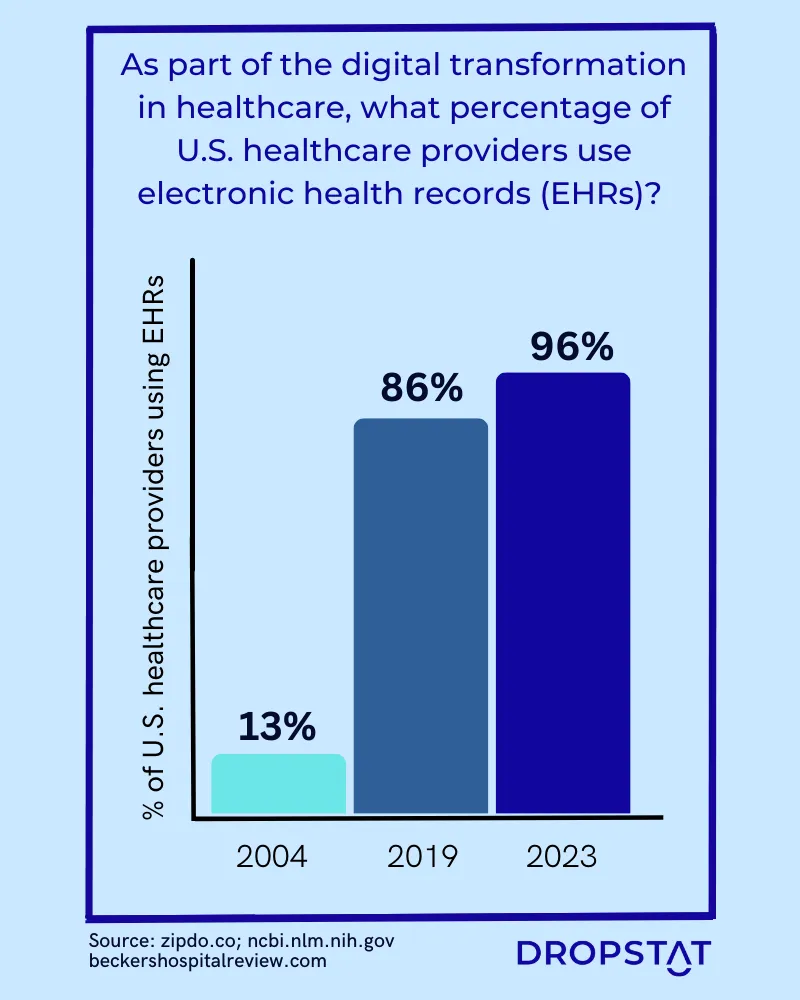
Why is the digital transformation important in healthcare?
Digital transformation is important in healthcare because it allows healthcare stakeholders to take advantage of the products of research and development. These advantages include:
- improving patient outcomes
- producing more diagnostic tools
- generating more accurate diagnoses
- enabling faster treatment (a shorter patient journey)
- providing personalized care
- using health information technology in healthcare to communicate and store patient test results and data, such as by use of electronic health records (EHRs)
Trends in health information technology continually morph into greater and more powerful healthcare tools. The way we use these tools ranges from controlling the supply of healthcare equipment, which is practical and tangible, to managing big data systems, which are virtual and intangible.
These tools and systems include:
- Deep learning models that can analyze vast amounts of data
- Tracking of patients, health symptoms, and referrals
- Improving patient data accessibility to professionals and patients through patient portals
- Digitalization of healthcare supply chain management
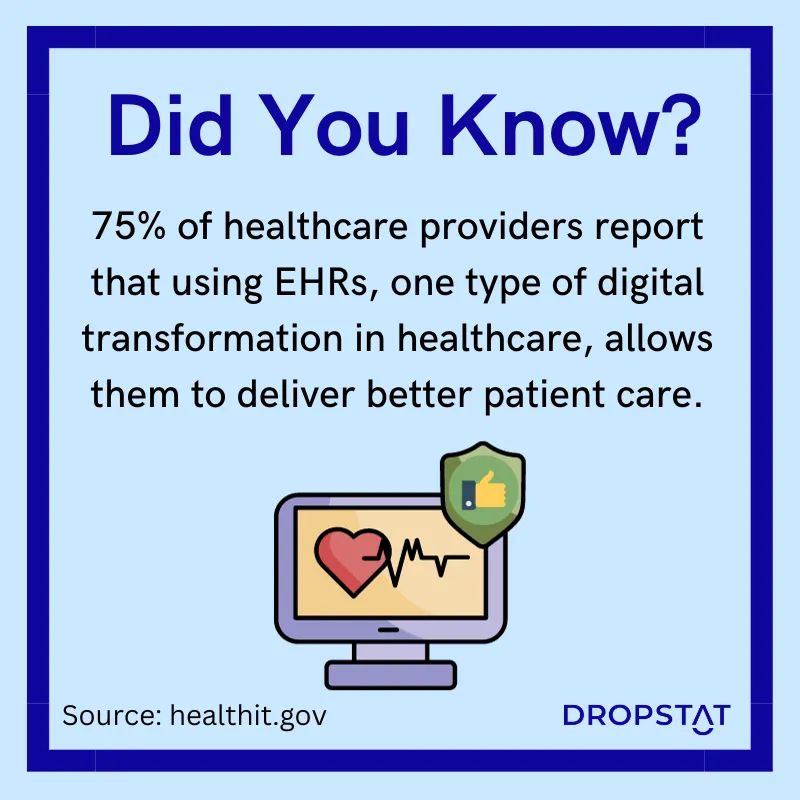
What are the barriers to digital transformation in healthcare?
Karl Forsberg, a healthcare IT leader, identifies several barriers to digital transformation in healthcare (in a discussion for LinkedIn). Digital transformation in healthcare, by definition, involves change. He sees all the barriers as subcategories to “resistance to change” in healthcare. These are some of the issues healthcare transformers face:
- A lack of awareness – the benefits of digital transformation in healthcare are not fully understood.
- Financial hesitancy – healthcare organizations are reluctant to spend money on new digital tools.
- Too many unknowns – how will technology impact workflow and care delivery? How will it impact jobs?
- Lack of healthcare educators and facilitators who are trained to use the new tools, to train other healthcare staff, and to educate patients in using the new systems and tools.
One conclusion we draw is that stakeholders must overcome resistance to change in order to adapt to the inevitable digital transformations in healthcare.
Additionally, patients and policymakers are concerned about the lack of privacy policies with respect to mobile health apps. Privacy and cybersecurity issues remain at the forefront of any discussion about digital healthcare.
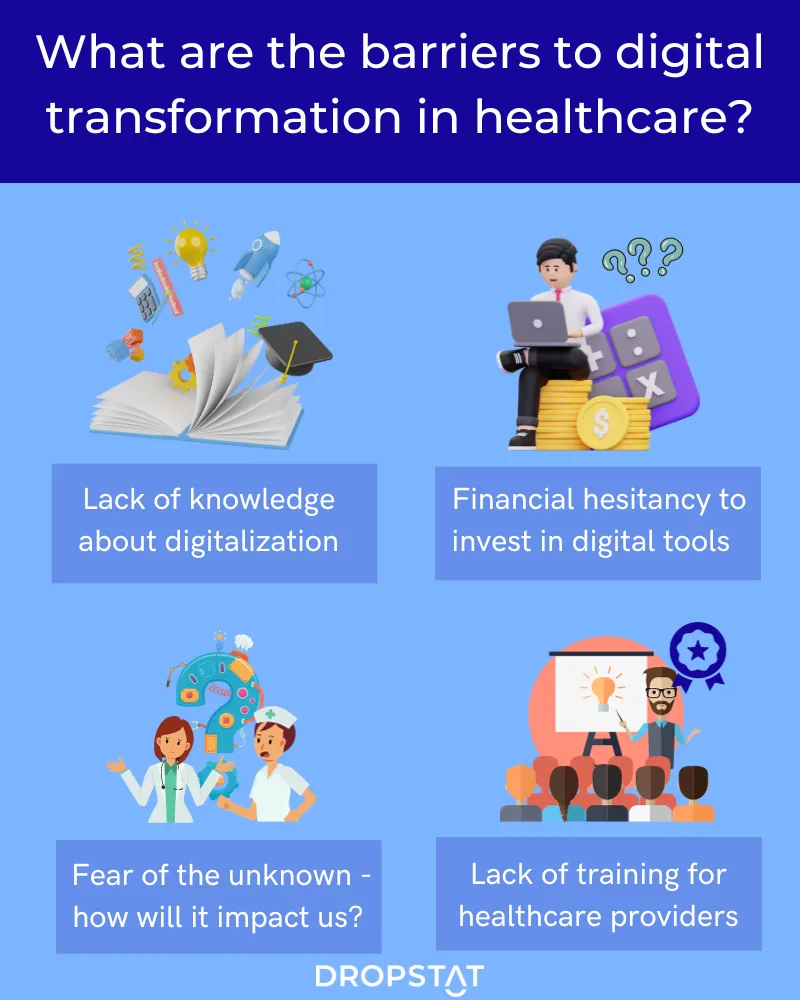
6 routes to provider success with digital transformation in healthcare
The digital healthcare industry offers many benefits. Here are some ways to take advantage of these to stay ahead of the curve in healthcare.
1. Adopt cloud solutions
Get around staffing shortages for skilled health IT professionals by moving chunks of the workload to the cloud. This adds flexibility, with access to highly skilled professionals who are located virtually and access to sharing advanced healthcare tools that healthcare organizations could not afford otherwise.
2. Use data for decision-making
Healthcare organizations can use data analysis tools to support evidence-based practice and:
- Make decisions faster and more easily, cutting out in-between stages
- Improve workflows and processes within the healthcare organization by integrating data across systems and using newer frameworks and platforms to handle data.
- Access analytical tools that interpret healthcare data and support decision-making by suggesting the next step for patients.
3. Apply automation solutions
Automation in healthcare means using new solutions to replace outdated manual processes. Digital tools and digitization of health records enable solutions such as virtual monitoring and harnessing AI in healthcare for contact center optimization that offers consumer support or directs patients to the department they seek. Often, organizations struggle to hire operators for contact centers. By introducing artificial intelligence, the hiring challenge is reduced, and consumers get help without waiting for a service representative to become available. 40% of clinical AI users use AI-powered tools for operational support. Many consumers prefer how AI is used in healthcare since it often saves time.
4. Take advantage of digital health funding
Large digital health investors support funding for start-ups. Hospitals can partner with developers to streamline the development of digital health solutions for specific healthcare situations and develop software as a medical device (SaMD). Healthcare organizations can unlock greater efficiency by linking up and working with innovators toward solutions.
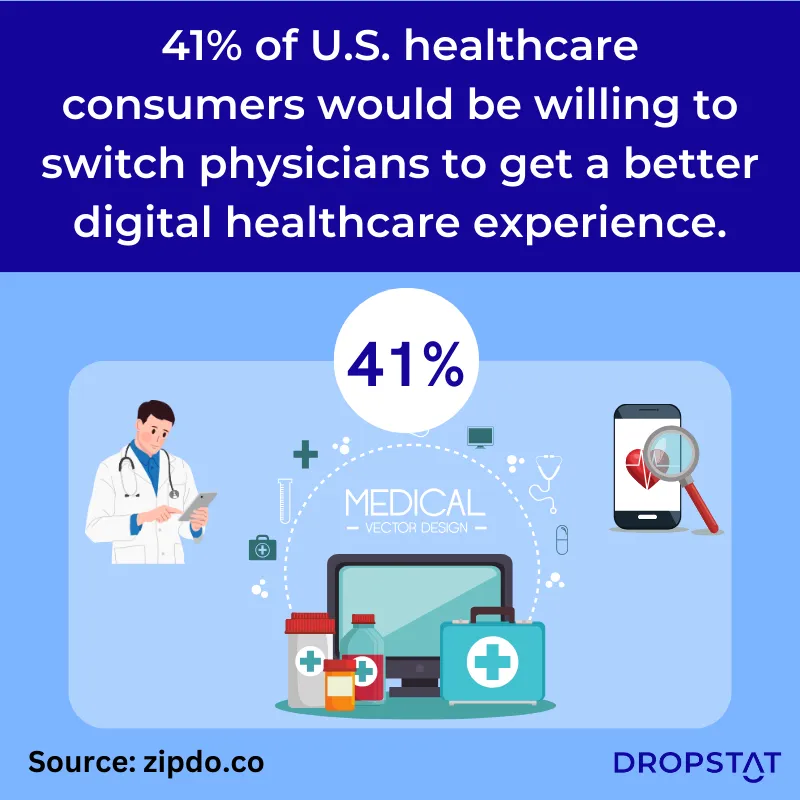
5. Improve customer experience
Healthcare consumers benefit from better patient experiences. Healthcare consumers and their families expect a high level of service, including enhanced communication, a faster patient journey to diagnosis, access to their healthcare data, and transparency in healthcare costs. Organizations that use digital tools can offer patients greater access to better care options.
6. Empower healthcare employees
Healthcare leaders and CEOs can set programs in place for employees to train in advanced digital healthcare skills. Instead of fearing that technology will take their place, employee morale will improve when employees know they have the new skillsets necessary for working with the digital transformation of healthcare.
We have touched on several examples of digital transformation in healthcare. By adopting change in healthcare through supporting the digital transformation in the healthcare industry, healthcare organizations will be set to improve and scale their operations and offer more to all stakeholders in healthcare.
Accessing digital transformation trends in healthcare
Accessing and applying digital transformation trends in healthcare is best done in a calculated and very supportive manner. Healthcare organizations can take action at the level of investment and change they choose:
- Hire a digital transformation specialist from an external company
- Invest in the role of CIO – in-house chief information officer
- Train existing managers in leading digital transformation
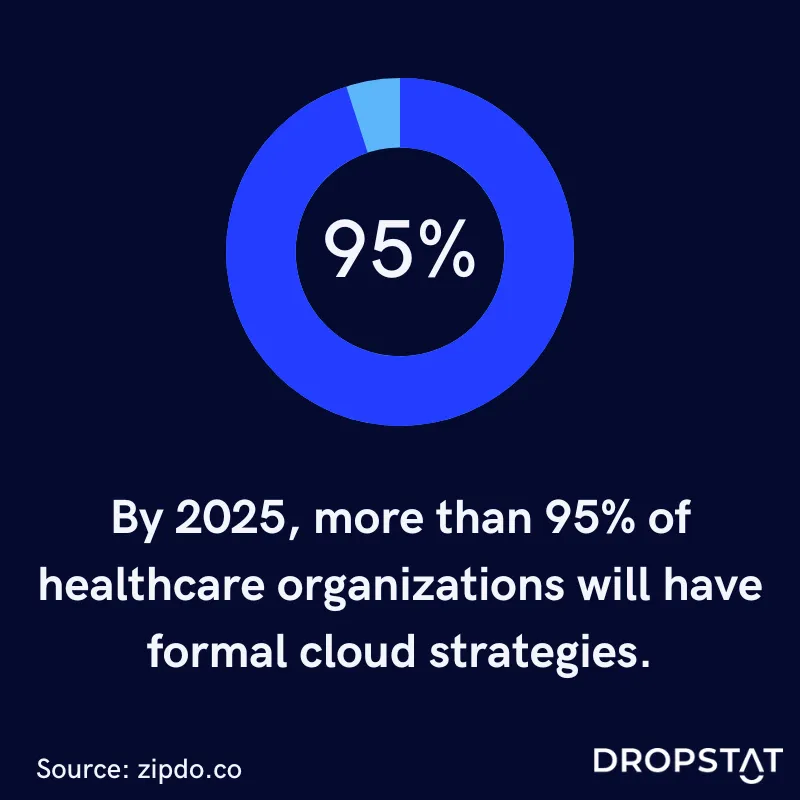
How Dropstat is leading a digital transformation in healthcare with staffing and nurse-scheduling technology
Dropstat, an AI-powered staffing and nurse-scheduling solution, supports digital transformation in healthcare organizations. Dropstat is leading digital transformation in healthcare by enabling all healthcare settings to optimize staffing. Nurse schedulers set up nurse schedules in advance, with accessible and easily viewable charts, enabling all nurses to know when they will be working. Nurse schedules can be set up to 2 months in advance, increasing nurse accountability.
With Dropstat’s hypercare, implementing change is feasible and possible for facilities of all sizes. Digital transformation in healthcare begins with Dropstat, where you can see exactly which staff work every shift in every department. Not only can managers confirm that a shift is HPPD-compliant, but you can see immediately if nurses of the correct discipline and qualifications are present for every shift, increasing financial efficiency and satisfying federal requirements.
Schedule a demo today to learn how Droptstat can help you stay ahead of the digital transformation curve in healthcare.
Digital transformation in healthcare FAQ
How does personalized healthcare feature in digital healthcare?
Personalized healthcare features in digital healthcare in three main ways:
1. The use of personalized healthcare tools, such as wearable devices, for self-monitoring and helping doctors collect information about the issues more accurately.
2. That patients and providers are connected more effectively and can communicate better, such as through the use of digital health records and patient portals for appointment reminders, results, emails, and two-way texting. Digitization of health records provides greater access for providers to patient’s medical histories; due to interoperability, this knowledge is increasingly becoming available across different systems.
3. The implementation of semi-automated tools to diagnose diseases more easily and build the patient journey more efficiently.







